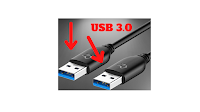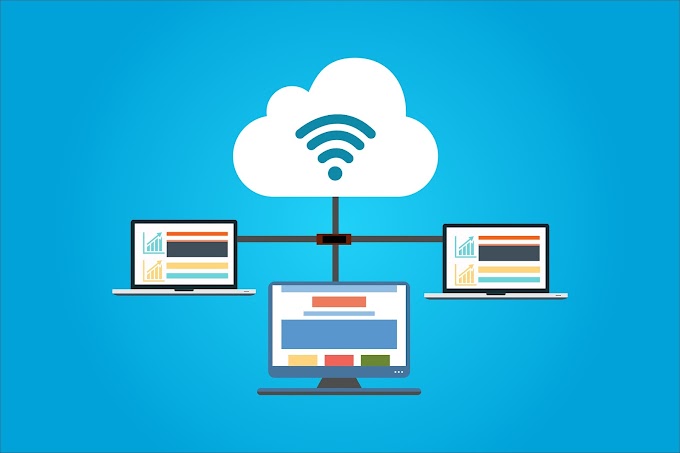What Is USB 3.0
USB
3.0 is a specification for the Universal Serial Bus (USB) that was
introduced in November 2008. This standard, also known as SuperSpeed
USB, is supported by the vast majority of modern computers and gadgets
on the market today.
The
USB 3.0 standard allows devices to send data at a theoretical maximum
rate of 5 Gbps (5,120 Mbps), however, the specification deems 3,200 Mbps
to be more practical in regular use. This is in sharp contrast to prior
USB standards such as USB 2.0, which can only transmit at 480 Mbps at
most, and USB 1.1, which can only transfer at 12 Mbps.
Although USB4 is the most recent USB specification, USB 3.2 is an improved version of USB 3.1 (SuperSpeed+). The theoretical maximum speed of USB 3.2 is 20 Gbps (20,480 Mbps), while USB 3.1 has a maximum speed of 10 Gbps (10,240 Mbps).
 |
Who Makes Use Of USB 3.0?
To utilize a 3.0-type USB, you don't need to be a tech whiz. Because this connector is so widely used nowadays, practically everyone who has a data connector, power cord, or flash drive is using a USB 3.0 without even realizing it.
For one thing, when you put a wired mouse or keyboard into your PC, you're probably unintentionally utilizing USB 3.0. The card you're using to charge your Android phone may be a Type-C USB!
What Is The Speed Of USB 3.0?
The potential transmission speed of USB 3.0 is 5 gigabytes per second (Gbps). This implies that a 1.5GB HD movie may be transmitted in less than a second from one device to another utilizing it (theoretically).
USB 3.0 transports file substantially slower in real-world tests than theoretical rates. According to a Macworld test, a 10GB file can be transferred to a hard drive at 114.2 Mbps using USB 3.0. That's around 87 seconds (or about a minute and a half). Although this may not appear to be a rapid speed, it is really ten times quicker than USB 2.0.
How To Determine Whether A USB Device Is 3.0
The easiest way to tell if a USB port is 3.0 is to look at its color. To distinguish USB 3.0 from earlier USB standards, most manufacturers will use blue color. The letters SS, which stand for "SuperSpeed," are sometimes printed on the cable or near the port.
A male connector (known as the plug) and a female connector (known as the plug) are used in USB 3.0. (called the receptacle or port). Today, there are four different types of USB 3.0 connections.
USB 3.0 Transfer Rate
USB 3.0 has a potential transmission speed of 4.8 Gbit/s (600MBps) compared to 480 Mbit/s (60MBps), which is a 10X increase. External hard disk sustained transfer speeds (in real life) are around 85MBps for USB 3.0 and 22MBps for USB 2.0, a 5X improvement but still a considerable improvement in transfer speed.
USB 3.0 SuperSpeed At 5Gbps
Thanks to USB 3.0 and an innovative Via-Labs VL812 chip, you may get 5Gbps SuperSpeed for exceptional performance, quick and consistent data transmission, and time savings. This USB 3.0 Hub works with a wide range of desktops, laptops, smartphones, tablets, and other USB-connected devices. For super-fast 5Gbps data transfer, connect the provided USB 3.0 cable to any USB 3.0 port. Of course, this USB 3.0 hub works with USB 2.0 and 1.1 as well.
Smartphones With USB 3.0
USB 3.0 reduces the total strain on the CPU and on-chip bus, resulting in quicker performance and reduced power consumption for mobile devices. This frees up more power, CPU cycles, and bus bandwidth to support high-end capabilities like graphics processing while also extending battery life. System makers now have additional possibilities for integrating features and add-on items that provide customers more value from their smartphones, thanks to the availability of USB 3.0 dual-function device IP controllers and Phys.
The availability of USB 3.0-based cellphones will have a favorable influence on the whole ecosystem of USB 3.0 market sectors, including tablet PCs, personal computers, digital storage, televisions, set-top boxes, and digital still and video cameras. New devices must support USB 3.0 to be ready for the next generation of "SuperSpeed" USB-capable cellphones. Product designers should consider whether they are "Ready for USB 3.0."
Summary
Even without factoring that USB 3.0 is full-duplex and USB 2.0 is half-duplex, USB 3.0 provides transmission speeds of up to 5 Gbit/s, which is roughly 10 times faster than USB 2.0 (0.48 Gbit/s). As a result, USB 3.0 has a total bidirectional bandwidth that is twenty times that of USB 2.0.
FAQs Frequently Asked Questions
Is USB 3.0 And USB C The Same Thing?
The main difference between USB-C and USB 3 is that one is a type of USB connection, while the other is a speed standard for all USB cables. It is used in some products in place of older USB-A connections or micro-USB ports. USB 3, on the other hand, is a standard for USB devices.
How Can I Tell Whether My Computer Has A USB 3.0 Port?
Determine whether or not your machine has USB 3.0 ports. Examine your computer's hardware ports. A USB 3.0 port is identified by a blue hue on the port or by marks adjacent to the port that say "SS" (SuperSpeed) or "3.0."
What Is The Difference Between A USB 2.0 And A USB 3.0 Connection?
What exactly is USB 3.0? USB 3.0 (sometimes known as USB 3) refers to a new generation of USB ports. The most significant distinction between USB versions is the transmission rate (speed) and the number of connecting pins. USB 3.0 ports feature 9 pins and a 5 Gbit/s transmission rate, whereas USB 3.1 ports offer 10 Gbit/s.
What Is The Difference Between USB 2.0 And USB 3.0 Ports?
Backward compatibility is guaranteed with USB 3.0 ports. When attached to a USB 2.0 port, however, a USB 3.0 disk will transmit at the same speed as a USB 2.0 drive. In other words, to obtain the fast data transfer rates than USB 3.0 is known for, a USB 3.0 drive must be linked to a USB 3.0 port.
What Can You Do With USB 3.0?
For starters, USB 3.0 connectors allow you to transfer data much faster than USB 2.0 connectors. You can copy or save files into your external hard drive faster with this connector version.
Do All USB 3 Ports Have The Same Color?
USB 3.0 ports usually have a bit of blue around or within the jack itself, as opposed to older UBS ports. The faster port may also be labeled with a "3.0" or "SS," which stands for SuperSpeed USB, on some laptops.
Conclusion
USB 3.0 introduces a new transfer mode dubbed "SuperSpeed" (SS), which can transport data at up to 5 Gbits/s (625 MB/s), which is more than ten times faster than USB 2.0's peak speed of 480 Mbits/s (60 MB/s).


.png)








0 Comments